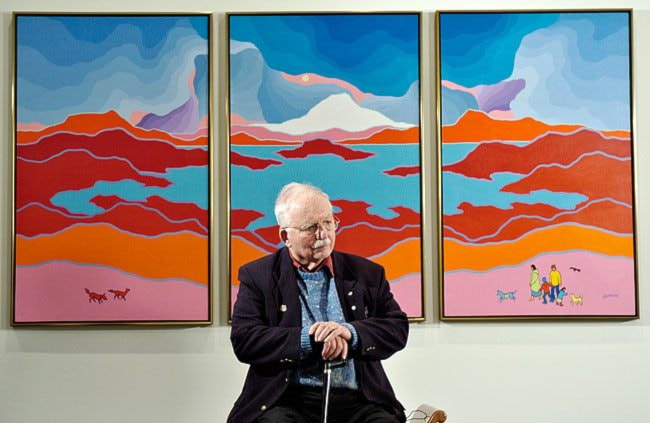Ted Harrison, one of the Yukon’s most recognized artistic ambassadors, died Friday at his home in Victoria. He was 88.
Harrison’s bright, bold paintings became synonymous with the northern landscape that inspired them.
But it was his support of artists, and his encouragement of others to explore their artistic side, that those who knew him are going to remember.
“He was just a very strong believer in the creative part of every person that lived. That they all had a creative part in them and if you nourish that then it will make you a better person,” said Ruth McCullough, who was the Yukon government’s first arts consultant and later a curator of the art gallery of the Whitehorse Public Library.
Harrison was born Aug. 28, 1926 in the village of Wingate in County Durham, England.
In 1943, he enrolled in Hartlepole College of Art.
He went back to school after the war and earned a diploma in design and later a teaching certificate.
Harrison and his wife Nicky would settle in the Yukon in 1967. He would stay until 1993 when he moved to Victoria.
Before he worked full time making art, Harrison was an art teacher in the Yukon at the vocational school and F.H. Collins Secondary School.
“He pulled out the best in every student,” said Laurel Parry, a student at F.H. Collins in 1978. “He created an atmosphere that was almost like an artist’s studio or salon.”
In class, students would pause from their work and Harrison would give what he called “sermons.”
Off the top of his head, he would talk about art history and the impacts of various artists from around the world.
“Because he told stories about art, he really connected us to the world of art making… He was so passionate about having found his artistic voice, and he believed that everyone had that and that his job as a teacher was to pull it out of people.”
When news of Harrison’s death broke, Parry posted something on her Facebook page.
As comments started coming in, she noticed that many of her former classmates had discovered artistic outlets of their own - not always as a profession, but just as a way to express themselves.
“There’s one that’s a glass blower and another that’s a jewelry maker and another one built an absolutely beautiful home and put her own stain glass in it.”
Photographer Heather Jones was a student of Harrison’s at F.H. Collins from 1976 to 1978.
She describes herself as a shy student who would often help clean the art room after class.
“It was during these after-school times that I pushed through my shyness and shared my interest in photography with Ted. He challenged me to create a story with my photos and share it with my peers as my ‘project,’” Jones wrote in a Facebook post.
“The end result was my arriving at class with a vinyl record with a very well-worn track of Joan Baez’s “Windrose,” a slide projector and a carousel with 50 or so images of ravens and ice fog that I had spent hours shooting and organizing.
“The nearly four minutes of my ‘presentation’ were a mix of terror and exhilaration. At its end Ted led the applause in the darkness as my last raven took flight and later took me aside to talk about the meaning of creativity, nurturing the artist within.”
Harrison’s paintings can be found in private and public collections throughout Canada, New Zealand, Japan, Germany and the United States.
In 1987 he received the Order of Canada.
Even as his own career took off, friends say Harrison was always willing to support other artists.
McCullough remembers putting on an exhibition at the art gallery of First Nations artists Jim Logan and Ray Ladue. It was their first exhibition and Harrison showed up.
“If you had an event he would be there, supporting everybody,” she said.
McCullough said Harrison grew to become a mentor of hers. They would sit and have tea on the back porch of his Porter Creek house.
That part of the house had a glass enclosure where Harrison would paint.
“He wanted that northern light,” she said.
She remembers her friend as someone who was always willing to use his talent to help a good cause - a signed print for a charity raffle or a discounted price for art being donated to public spaces.
Harrison was born in 1926, the year of the U.K. general strike, and was a child during the Great Depression.
“He saw generosity in the most difficult of times and that’s how he was raised,” said biographer Katherine Gibson, who wrote about Harrison in her 2009 book.
When it came time for Yukoners to return the favour, they didn’t disappoint.
In the early 1980s, McCullough was curating a retrospective exhibition of Harrison’s work to send on tour to galleries across Western Canada. She wanted about 100 pieces, and it meant handing them over for about a year.
She doesn’t remember a single person turning her down.
“Of course we would,” she heard time and time again. “Anything for Ted.”
That connection to the North didn’t go away when Harrison left the territory.
“Even after more than 20 years in Victoria his heart was always in the Yukon. That never changed. That’s for sure,” Gibson said.
When the book came out, Harrison returned north on a book tour. The lineup to get an autograph was huge.
“People were just so happy to see him,” McCullough remembers.
Contact Ashley Joannou at
ashleyj@yukon-news.com
